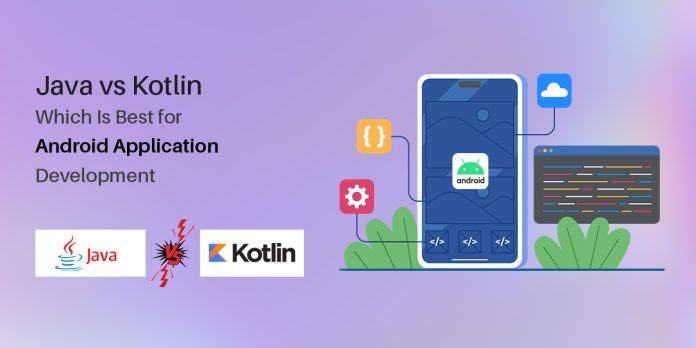Both Java and Kotlin are widely utilized for developing Android applications. Both languages have advantages and disadvantages, so picking one over the other often depend on the project’s particular needs and the development team’s preferences.
To help you decide which language is ideal for your android application development company, we will compare Java versus Kotlin based on several criteria, including syntax, performance, interoperability, community support, and ecosystem.
● Introduction to Java and Kotlin:
Java:
Java is a stable and widely-used computer language used to make Android apps since the platform’s beginning. It’s known for how easy it is to use and read and how many books and tools it has.
Kotlin:
JetBrains, the company behind famous integrated development environments (IDEs) like IntelliJ IDEA, made Kotlin a current computer language. Kotlin is built to work well with Java and has several tools that make Android development faster and easier.
● Syntax and Readability:
Java:
The C-like syntax used by Java is comfortable for many programmers. Compared to Kotlin, it has a more verbose syntax, which might increase the likelihood of writing repetitive code. Nevertheless, there is a sizable Java development community, and the language’s grammar is well-known and easy to learn.
Kotlin:
The syntax of Kotlin is shorter and more flexible than Java’s. Type inference, extension functions, and data classes are just ways it cuts down on repetitive coding tasks. Because of its more understandable syntax, Kotlin enables developers to create code that is also less daunting to maintain.
● Null Safety:
Java:
Developers must manually manage null values using null checks and conditional statements since Java lacks built-in null safety capabilities. This may increase the risk of issues and even cause null pointer errors during android app development service.
Kotlin:
Kotlin has built-in support for preventing errors caused by null pointers. It adds nullable and non-nullable types, safe call and the Elvis operator, which help contain errors caused by handling null values. The null safety features of Kotlin may make Android apps much more reliable.
● Interoperability:
Java:
Interoperability between Java and Kotlin is complete. Java code can quickly call Kotlin code, and Kotlin code can call Java code with little to no work on either side. This allows a progressive transition from Java to Kotlin using previously developed code and resources.
Kotlin:
Kotlin was created with Java compatibility in mind. It’s fully compatible with using Java libraries and calling Java programs. Additionally, Kotlin has capabilities like extension methods that let Kotlin code improve upon preexisting Java classes without altering them.
● Performance:
Java:
Java’s speed has steadily improved through many years of optimization. It has a fully developed Just-In-Time (JIT) compiler that can optimize code execution on the fly. Java programs are usually very fast, which makes them a good choice for Android apps that do a lot.
Kotlin:
Kotlin is compiled to bytecode and executed on the Java Virtual Machine (JVM), exactly like Java. As a result, Kotlin’s efficiency is on par with Java’s. However, the extra checks required by Kotlin’s null safety features sometimes cause a small cost.
● Community Support and Ecosystem:
Java:
Java has long been the language of choice for Android development due to its extensive and well-established ecosystem. A large community supports Java and has many resources, including libraries, frameworks, and tools. The fact that many Android programmers are already conversant in Java facilitates the availability of both resources and experience.
Kotlin:
Kotlin has become much more famous in the Android industry since Google said it would officially support it. The Kotlin ecosystem has grown out of control due to the overproduction of tools and frameworks. Kotlin has an active community, and many coders use it for Android development.
● Language Features:
Java:
Java is a statically typed language with rigorous type verification requirements. Classes, interfaces, and inheritance—all aspects of object-oriented programming—are fully supported. However, Java needs several current language features that help make code more concise and expressive, such as extensions, coroutines, and higher-order functions.
Kotlin:
Kotlin has many cutting-edge language features, including higher-order functions, lambda expressions, and coroutines. These capabilities allow programmers to produce more concise and expressive code, increasing productivity and improving code quality.
● Development Speed:
Java:
Java is sometimes wordier than Kotlin, slowing development down. Unlike Kotlin, developers need to write more lines of code to get the same features. But Java has a mature tools environment that can help devs speed up the development process.
Kotlin:
Kotlin’s clear grammar and current language features can significantly speed development. It reduces repetitive code and lets writers make their intentions more explicit. Interoperability with Java allows devs to use Kotlin alongside current Java codebases.
● Learning Curve:
Java:
Java has been around for a while. Consequently, there are tried-and-true ways to start using it. Numerous books, online courses, and tutorials are available to help you learn Java. Developers may switch to Java from other languages because of the familiarity with its syntax and principles.
Kotlin:
Kotlin is a more recent language than Java, but it is quickly gaining popularity. There are not as many places to learn Kotlin as there are for Java, but there are still many tutorials, online courses, and books accessible. Kotlin’s compatibility with Java makes it easy for developers to pick up on the language’s syntax and ideas.
● Tooling and IDE Support:
Java:
Java’s tooling support is first-class, and many IDEs are available. Code completion, debugging, and refactoring tools are a few of the robust capabilities available in popular Java IDEs like Eclipse, IntelliJ IDEA, and NetBeans.
Kotlin:
One of the most widely used integrated development environments (IDEs) for Android development, JetBrains’ IntelliJ IDEA fully supports Kotlin. Some examples of how IntelliJ IDEA assists with Kotlin development are code analysis, refactoring tools, and debugging. Due to Google’s formal sponsorship of the language, other IDEs, such as Android Studio, also provide strong support for Kotlin.
● Adoption and Industry Trends:
Java:
Java has been used extensively in the Android ecosystem and is the de facto standard for Android development. Java is a popular programming language used to generate many of the existing Android applications. However, Kotlin is quickly becoming the language of choice for Android developers, and Google is actively advocating for it.
Kotlin:
After Google announced its formal support for Kotlin in 2017, it quickly became a popular choice among Android developers. Kotlin has been gaining popularity among developers, who use it for new Android projects and the slow migration of old Java codebases. Kotlin’s better developer experience and cutting-edge capabilities have made it the go-to language for creating Android apps.
● Maintenance and Long-Term Support:
Java:
Java has been around for decades. Thus, its reliability and longevity as a programming language are well-established facts. Because of its vast development community, it receives frequent upgrades that address security concerns and solve bugs. The rich ecosystem of libraries and tools guarantees support for Java-based Android apps.
Kotlin:
JetBrains, a reputable software development firm, stands behind Kotlin and offers robust support and frequent upgrades. Kotlin is created to be fully backwards compatible with Java, enabling compatibility and support for already available Java-based Android applications. The ever-expanding Kotlin community monitors the language’s progress and provides feedback, guaranteeing its continued upkeep and support.
● Migration from Java to Kotlin:
Java:
It is possible to convert an existing Java codebase to Kotlin gradually. Kotlin’s compatibility with Java extends to the point where the two languages may coexist in the same project without any incompatibilities. IDEs like IntelliJ IDEA offer automatic tools that enable using Kotlin in Android apps.
Kotlin:
Kotlin makes it easy to switch from Java by providing helpful migration tools. To facilitate the transition from Java to Kotlin, IDEs include tools like code conversion, automated nullability management, and recommendations. Because of Kotlin’s compatibility with Java, applications written in one language may easily interact with those reported in the other.
● Community and Future Growth:
Java:
Java has a large developer base and an extensive ecosystem. It’s a tried-and-true language utilized across the board, including in the Android developer community.
Since there is already so much Java code and so many Java developers, the language will continue to see widespread usage even if the introduction of Kotlin slows the development of new Java-based Android apps.
Kotlin:
Kotlin has increased in the Android community since Google made it an official language. It has become very famous among developers because it has new features and improves the developer experience.
A lot is happening in the Kotlin community, and the language’s ecosystem is expanding, including creating additional languages, frameworks, and tools. In the future, Kotlin for Android apps will grow and be used more.
Conclusion
Due to their respective capabilities, Java and Kotlin are viable options for creating Android apps. Java is a well-established language with an extensive ecosystem and a sizable population of programmers. It’s a safe bet to keep using and improving on current Java codebases while using the many Java libraries and development tools that are available.
Kotlin, on the other hand, has cutting-edge language features like excellent safety via nullability handling and increased developer efficiency. It is becoming more popular among leading android app development company, so consider using it for your next project or while porting over from Java.
Project needs, development team skills, code compatibility, and individual taste are all important considerations when deciding between Java and Kotlin. Before settling on a course of action, assessing these aspects and considering your Android app’s unique requirements is crucial. Remember that there is constant change in the Android development ecosystem and that your long-term success depends on your ability to adapt.






